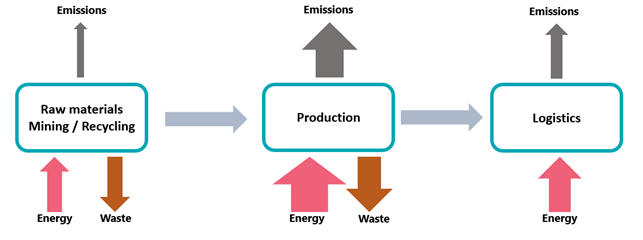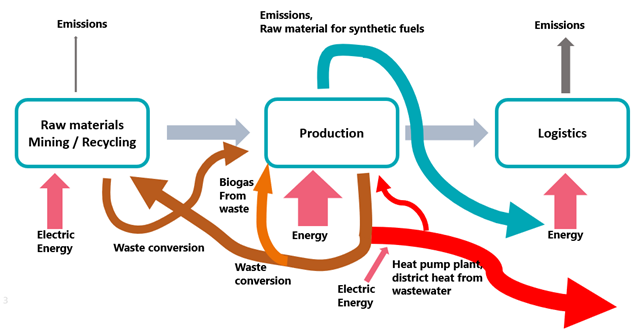02/02/2023
Energy crisis or growing pains?
The options for solving the energy crisis have been known for a long time – now the actual solving of the issues should take priority. In Finland, the forest industry produces a large portion of the renewable energy, but also uses a lot of energy just the same. Our special characteristics also include our district heating network that enables the large-scale distribution of heat from different sources. We need investments in things such as promotion of the circular economy and storing of energy.
In the last few months, the headlines have been dominated by the energy crisis. However, according to one definition, a crisis is a new situation or turning point encountered by a human or organization wherein the learned problem-solving skills may not work anymore. In the big picture, the situation in the energy market does not really correspond to this definition of a crisis.
The system built on fossil fuels is, despite everything, approaching the end of its life. The inevitable progress has just been forced to leap forward, which naturally causes more sudden growing pains than a controlled change would. However, the direction of the long-term development is not changing.
A clear consensus of needs and means has prevailed for a long time
Naturally, the price of energy is an issue for many households, companies and communities, to put it mildly. But the proposed solutions, such as investment in energy and resource efficiency and renewable energy, have been known to us for at least a decade. Ensuring our survival does not require doing anything new or surprising.
The private persons, communities, companies and states that have taken action in a frontloading manner may escape the crisis completely. The seed of a much more severe crisis lies in the continuous use of fossil fuels.
Finland has strived for a quick change
The path of the EU and Finland towards carbon neutrality has been presented in both the general roadmap of the EU and the roadmap of Finland. The EU strives to achieve carbon neutrality by 2050, whereas the objectives of Finland are considerably more ambitious: our country wants to be carbon neutral by 2035. Countries such as Japan and China have also presented their own targets.
In any scenario, achieving these targets would have required actions that would be painful to at least some parties. Now we have a taste of the things to come, because we have had to take action in one fell swoop. The list of necessary actions remains massively long, and implementing the plans will not be easy.
The energy system of Finland is affected by whether the forest industry will start utilizing its side streams for purposes other than energy production, which will require compensatory energy production.
Long-term roadmaps often include perspective issues
When a target is set far enough into the future, there is no need to take unpleasant action in the current parliamentary term – in other words, now. The carbon neutrality of Finland or even the EU will not solve the global climate issues, if the additional production demanded by growth and the emissions related to it are outsourced. The bond between economic growth, consumption, and energy consumption is yet to be severed, which is part of the problem.
In addition to achieving zero-emission energy production, another essential task is building a circular economy that is both extensive and energy efficient. The benefits and disadvantages of the circular economy are largely determined through the energy consumption of the cycle processes and the disadvantages of the related energy production. Transparent and comprehensive lifecycle reporting must be developed to verify these factors and, of course, the benefits of a circular economy.
Finland currently utilizes wood-based biomass extensively
Every country and economic community has its own characteristics related to its regional energy systems. The special characteristics of Finland include the large amount of wood-based biomass it has in relation to its population, its forest industry that uses the biomass efficiently, and its district heating network to which I will return later.
The biomass reserves of Finland make the large-scale production of wood-based renewable energy possible. Of course, in political decision-making the degree of renewability depends on the agreed approaches and definitions. Biomass will possibly be defined in the EU region as renewable energy, which is an issue for the system in Finland.
Impact of forest industry is evident in both production and consumption
At the moment, the forest industry produces a considerable portion of the renewable energy in Finland, but the industry also uses a lot of energy. The forest industry participates in things such as frequency management and the reserve market, and is thus an essential operator in the Finnish energy system.
The processes and logistics that enable the efficient utilization of forest biomass have found their current forms through centuries of development. The forest industry has, throughout its history, survived many upheavals, such as the end of tar use and the crash in the demand for magazine paper. It will also survive the current crisis, and it will not only survive; it will be part of the fossil-free solution.
Side streams will continue to have a key role
At the moment, the energy production of the forest industry is largely based on burning unutilized side streams, such as lignin. Therefore, the energy system of Finland is affected by whether the forest industry will start utilizing its side streams for purposes other than energy production, which will require compensatory energy production. For example, the demand for heat pump solutions that are based on the utilization of waste heat might increase. In the future, we may see solutions such as small nuclear power reactors to generate heat.
The interest in utilizing side streams in the manufacture of physical products may come, for example, through EU regulation or as new innovations and products of a better level of added value become viable options. This will make using biomass for energy less appealing.
However, it is unrealistic to assume that the burning of side streams would cease completely, at least in the near future. The products or markets in which these raw materials could be utilized do not exist on a large enough scale.
The introduction of the circular economy must be accelerated as part of sustainable economic growth. The investments to be made in it will bear fruit in the future.
District heating network increases flexibility of energy system
The more urban Finland becomes, the larger is the part of the Finnish population living in an area covered by the district heating network. The district heating network enables the large-scale distribution and utilization of heat from multiple sources. The already utilized sources of waste heat include
- waste heat of industry
- heat from wastewater
- waste heat of data centers.
The district heating network also enables things such as the production and distribution of geothermal energy, which is practical in comparison to individual geothermal wells. The benefits of a good network also include an increasingly flexible energy system, when energy can be stored cost-effectively on a large scale.
Storing of energy is worth the effort
Preparing for the increasing need to store energy is a smart move. As long as the production profile of the industrial plant allows, effort should be made to store energy or to direct the use to occur at night. Cheap electricity can also be stored in heat accumulators and discharged as process steam, for example.
The optimized storing and flexible use of energy require a good understanding of the future consumption in relation to the price of energy, now and in the following hours or days. The prediction of short-term consumption requires the process to have reliable energy indicators, and, furthermore, the data produced must be adjusted and utilized in energy price data and forecasts.
“Zero waste” thinking is also required
The introduction of the circular economy must be accelerated as part of sustainable economic growth. The investments to be made in it will bear fruit in the future, similar to the way the investments made in renewable energy and energy efficiency in the past are now being rewarded.
The lifecycle calculations striving to verify the benefits, such as carbon footprint analyses and carbon handprint analyses, will become mandatory, because the consumers and financiers know to demand them. This is why companies should immediately develop their calculation and reporting methods. The entity related to energy and material flows must be rethought, which will challenge the benefit and disadvantage assessments and business models and make them more complex.


Introduction of unimplemented energy efficiency actions
On reflection, the solution to the present problems is to take the same actions that were supposed to be taken before the crisis. It is crucial to utilize the opportunities to optimize energy use so that the specific energy consumption required by the growth is as small as possible, leading to the investments in carbon neutral energy production remaining similarly as light as possible.
As someone who has spent almost their entire career working with energy efficiency, I know that the world is lamentably full of energy efficiency actions that are clearly recommended but still unimplemented. It is certain that our current standard of well-being could also be achieved at reduced energy consumption.
Want to know more? Check out these related articles:
How can we ensure industrial resilience during the coming winter?
The current energy crisis has forced us to think about how to secure critical infrastructure and manufacturing operations. Concrete measures include the implementation of emergency fuel systems and moving away from natural gas in production plants. We should also examine the threat scenarios and resilience of our own activities more broadly once we have overcome the acute situation.
Vaasan Sähkö has commissioned Elomatic to design and project manage a future heat pump plant
Vaasan Sähkö will have a plant built at the Pått wastewater treatment plant to recover waste heat from treated wastewater. The heat will be fed into the district heating network, where it will be sufficient to meet the needs of almost 2,000 private homes. Elomatic is responsible for the entire project, from the planning and procurement phase to construction management and commissioning. The project has gotten off to a good start, and the pieces have fallen into place for seamless cooperation.
